Low range differential pressure transducers are essential for monitoring and controlling air movement in a variety of applications, including ventilation systems, air extraction systems, and building management systems. These transducers typically feature two ports for measuring the pressure difference across a component such as a fan, filter, or valve. This allows for precise measurement of airflow and helps ensure efficient system operation.
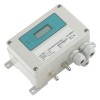 DPS Low Differential Pressure Transmitter - Ultra low differential pressure transmitter for HVAC applications with 4-20mA current loop or amplified voltage output signal in pressure ranges from 0.1 mb up to 1 bar differential.
DPS Low Differential Pressure Transmitter - Ultra low differential pressure transmitter for HVAC applications with 4-20mA current loop or amplified voltage output signal in pressure ranges from 0.1 mb up to 1 bar differential. 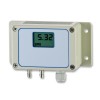 DPS200 HVAC Differential Pressure Transmitter - Differential air pressure sensor with a 10 volt or a 4-20mA output for building ventilation applications. Ranges from 0 to 6 mbar up to 0 to 1000 mbar.
DPS200 HVAC Differential Pressure Transmitter - Differential air pressure sensor with a 10 volt or a 4-20mA output for building ventilation applications. Ranges from 0 to 6 mbar up to 0 to 1000 mbar. DPS300 User Switchable Pressure Range, Volts or Current Output Low DP Sensor - The DPS 300 is a low range HVAC differential pressure sensor. The lowest possible pressure range is 0...100 pascals. 2 or 3 switchable pressure ranges, plus volts or current output are included with most standard configurations.
DPS300 User Switchable Pressure Range, Volts or Current Output Low DP Sensor - The DPS 300 is a low range HVAC differential pressure sensor. The lowest possible pressure range is 0...100 pascals. 2 or 3 switchable pressure ranges, plus volts or current output are included with most standard configurations.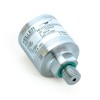 41X High Precision Low Range Pressure Transmitter - High precision pressure transmitter for measuring very low vented gauge reference or differential air pressures. Rangeable 4-20mA or 0-10 volt output.
41X High Precision Low Range Pressure Transmitter - High precision pressure transmitter for measuring very low vented gauge reference or differential air pressures. Rangeable 4-20mA or 0-10 volt output.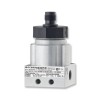 DMD341 Compact Differential Air Pressure Sensor - Small size dp sensor for measuring differential air pressure on HVAC, compress air and pneumatic control systems.
DMD341 Compact Differential Air Pressure Sensor - Small size dp sensor for measuring differential air pressure on HVAC, compress air and pneumatic control systems.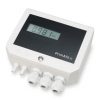 PrimAtü 10 Low Cost Low Range Differential Air Pressure Transducer - The PrimAtü 10 low cost low range differential air pressure transducer can detect and display both positive and negative differential pressure variations of very low low pressure ranges from 0.5 up to 1000 mbar/hPa, and output the pressure as a 4-20mA, 0-20mA or a 0-10Vdc analog output.
PrimAtü 10 Low Cost Low Range Differential Air Pressure Transducer - The PrimAtü 10 low cost low range differential air pressure transducer can detect and display both positive and negative differential pressure variations of very low low pressure ranges from 0.5 up to 1000 mbar/hPa, and output the pressure as a 4-20mA, 0-20mA or a 0-10Vdc analog output.
- Low delta P sensor with 200mmH2O range and response time < 5ms
- 10 mmWC draft fan differential pressure transmitter
- Monitoring data center positive pressure with a low-range differential transducer
- 20 pascal differential pressure transducer for clean rooms
- 20 Pa DP range 0-10V output air pressure sensor for building management use
Find out more about Low Range DP Voltage Output Transducers to determine which product options and capabilities will best meet your application requirements.
Low range differential pressure (DP) transducers are specialized sensors designed to accurately measure small pressure differences in air handling systems. These transducers are particularly useful in applications where low-pressure differentials are critical, such as ventilation systems, air extraction systems, cleanrooms, and air scrubbers.
Applications
Low range differential pressure transducers with voltage outputs are widely used across various industries for precise pressure monitoring and control. These transducers offer a convenient and versatile solution for measuring small pressure differences in air handling systems, ensuring optimal performance and efficiency. Let’s explore some common applications and the typical voltage output signals and pressure ranges employed:
Ventilation Systems
Maintaining proper airflow and air quality in ventilation ducts, ensuring adequate ventilation in buildings and industrial facilities. Monitoring pressure differences across filters to assess their condition and schedule replacements, preventing airflow restrictions and energy waste.
0-10V is a commonly used analog voltage output signal for ventilation applications. This signal provides a linear representation of the measured pressure difference, allowing for easy integration with building management systems (BMS) and control systems.
Typical pressure ranges for ventilation systems are 0-1 inWC (0-250 Pa), 0-2 inWC (0-500 Pa), and 0-5 inWC (0-1250 Pa). These low ranges ensure accurate measurement of the small pressure differentials commonly encountered in ventilation ducts and filters.
Cleanrooms
Maintaining positive pressure differentials in cleanrooms to prevent the ingress of contaminants and ensure a sterile environment for critical processes like pharmaceutical manufacturing, semiconductor fabrication, and medical research. Monitoring airflow patterns and pressure gradients to optimize cleanroom performance.
0-5V or 0-10V voltage outputs are commonly used in cleanroom applications, providing high accuracy and stability for critical pressure monitoring. These signals can be easily integrated with cleanroom control systems and data acquisition systems.
Cleanrooms typically require very low pressure ranges, such as 0-0.5 inWC (0-125 Pa) or 0-1 inWC (0-250 Pa). These low ranges ensure precise measurement of the small pressure differentials required to maintain positive pressure and prevent contamination.
HVAC Systems
Measuring airflow in ducts and balancing air distribution in buildings to optimize HVAC system efficiency and occupant comfort. Monitoring pressure differences across coils, filters, and dampers to ensure proper system operation and energy efficiency.
0-10V is a widely used voltage output signal for HVAC applications, providing a linear representation of the measured pressure difference. This signal can be easily integrated with building automation systems (BAS) and HVAC control systems for precise monitoring and control.
Pressure ranges for HVAC applications can vary, but commonly used ranges include 0-1 inWC (0-250 Pa), 0-2 inWC (0-500 Pa), and 0-5 inWC (0-1250 Pa). These low ranges ensure accurate measurement of the small pressure differentials encountered in HVAC systems.
Filter Monitoring
Monitoring pressure drop across filters in various applications, including air handling units, dust collection systems, and industrial processes. Assessing filter efficiency, identifying clogging, and scheduling maintenance to ensure optimal filtration performance and prevent system downtime.
0-10V voltage outputs are commonly used for filter monitoring applications, providing a clear indication of pressure drop across the filter media. This signal can be used to trigger alarms, initiate filter replacements, and optimize filter maintenance schedules.
Pressure ranges for filter monitoring vary depending on the filter type and airflow requirements. Commonly used ranges are 0-1 inWC (0-250 Pa), 0-2 inWC (0-500 Pa), and 0-5 inWC (0-1250 Pa).
Laboratory and Research
Precise pressure measurement and control in laboratory and research settings, including flow chambers, fume hoods, and environmental control systems. Monitoring pressure differentials in experiments, ensuring accurate and reliable data acquisition.
0-5V or 0-10V voltage outputs are commonly used in laboratory and research applications, providing high accuracy and stability for critical pressure measurements. These signals can be easily integrated with data acquisition systems and laboratory equipment.
Pressure ranges for laboratory and research applications can vary depending on the specific experiment or process. Low pressure ranges, such as 0-0.5 inWC (0-125 Pa), 0-1 inWC (0-250 Pa), and 0-2 inWC (0-500 Pa), are often used for precise measurement of small pressure differentials.
